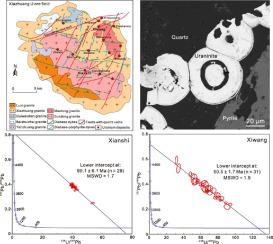Ore Geology Reviews ( IF 3.2 ) Pub Date : 2022-09-23 , DOI: 10.1016/j.oregeorev.2022.105120 Long Zhang , Fangyue Wang , Taofa Zhou , Zhenyu Chen

|
The Xiazhuang uranium ore field contains eighteen uranium deposits and is one of the most important granite-related uranium ore producers in South China. Silicified vein-type and intersection-type uranium deposits are the two main types of uranium deposits in this ore field. To constrain the mineralization ages and sources of uranium of these two types of uranium deposits, we present geochemistry and U-Pb isotopic data of uraninites from the representative Xianshi intersection-type and Xiwang silicified vein-type uranium deposits in the Xiazhuang ore field. Laser ablation-inductively coupled plasma-mass spectrometry (LA-ICP-MS) U-Pb dating on uraninite from the Xianshi deposit yielded the crystallization age of 89.9 ± 2.1 Ma, which is consistent with the emplacement age (∼90 Ma) of NNE-trending diabase porphyrite dykes in this area. Chondrite-normalized rare earth element (REE) patterns of uraninite from the Xianshi deposit are characterized by slight enrichment of light REE relative to heavy REE and weakly positive Eu anomalies. Our study suggests the involvement of mantle-derived metals in the formation of the Xianshi deposit. In situ LA-ICP-MS U-Pb dating on uraninite from the Xiwang deposit yielded a weighted mean age of 51.3 ± 0.8 Ma, which overlaps the timing of the 55–45 Ma crustal extension event in South China. Uraninite from the Xiwang deposit has much higher contents of W (5768–11305 ppm), Nb (294–1301 ppm), and Y (3013–6263 ppm) than those of uraninite from the Xianshi deposit (W = 291–371 ppm, Nb = 3–14 ppm, and Y = 1658–3149 ppm). Uraninite from the Xiwang deposit has “gull-winged” chondrite-normalized REE patterns with pronouncedly negative Eu anomalies, which resemble whole-rock REE patterns of the Maofeng and Xiazhuang granites. This study suggests that the Maofeng and Xiazhuang granites are probably the primary source of uranium for the Xiwang deposit.
中文翻译:

对比华南仙石和西王铀矿床铀矿的 U-Pb 年代学和地球化学:对成矿的启示
夏庄铀矿田拥有十八个铀矿床,是华南地区最重要的花岗岩相关铀矿生产地之一。硅化脉型和交叉型铀矿是该矿区铀矿床的两种主要类型。为确定这两类铀矿床的成矿年龄和铀来源,我们展示了夏庄矿田具有代表性的仙石交汇型和西王硅化脉型铀矿床的铀矿地球化学和 U-Pb 同位素数据。激光烧蚀-电感耦合等离子体质谱(LA-ICP-MS)U-Pb测年对仙石矿床铀矿的结晶年龄为89.9±2.1 Ma,与NNE的侵位年龄(~90 Ma)一致-该地区趋势的辉绿岩玳岩岩脉。仙石矿床铀矿的球粒陨石归一化稀土元素(REE)模式的特征是轻稀土相对于重稀土略有富集和弱正的Eu异常。我们的研究表明,地幔衍生金属参与了仙石矿床的形成。西王矿床铀矿原位 LA-ICP-MS U-Pb 测年得出的加权平均年龄为 51.3 ± 0.8 Ma,与华南 55-45 Ma 地壳伸展事件的时间重叠。西王矿床铀矿的 W (5768–11305 ppm)、Nb (294–1301 ppm) 和 Y (3013–6263 ppm) 含量远高于仙石矿床的铀矿 (W = 291–371 ppm, Nb = 3–14 ppm,Y = 1658–3149 ppm)。来自西王矿床的铀矿具有“鸥翼”球粒陨石归一化的 REE 模式,具有明显的负 Eu 异常,类似于茂峰花岗岩和下庄花岗岩的全岩稀土元素图案。这项研究表明,茂峰和夏庄花岗岩可能是西王矿床铀的主要来源。











































 京公网安备 11010802027423号
京公网安备 11010802027423号